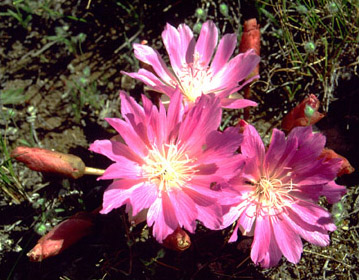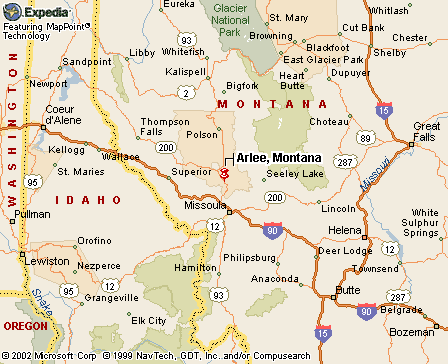|
|
Canku Ota |
|
|
(Many Paths) |
||
|
An Online Newsletter Celebrating Native America |
||
|
May 22, 2004 - Issue 113 |
||
|
|
||
|
Bitterroot Tradition Lives On |
||
|
by Mary Charlo-Crumley - Char-Koosta
News
|
||
|
credits: photo:
Bitterroot
|
|
The crowd mills patiently while members of the Culture Committee consult with some of the elders. Students of every age and size are there to be part of the day, from the small students of Nkwusm (a Salish-language immersion school in Arlee) to the college students in attendance. Tony Incashola, the director of the Salish-Pend d'Oreille Culture Committee, asks for quiet, announcing the beginning of the bitterroot dig. "A long time ago, our people were starving, and there was nothing to eat," he said. "An old woman went out into the prairie and was praying and crying to the Creator because the people were hungry. As her tears fell to the ground, the Creator gave us bitterroot as a promise that he would provide, and that the tribe wouldn't ever go hungry again. The root of the plant is white from the woman's hair, and the bitter taste comes from her tears. Since then, each spring, our people have waited until the elders said the root was ready to harvest, and gone out to give thanks, and collect this root, vital to our survival." Tony spoke to the group about the importance of the bitterroot to our Tribes, and as a people. Tribal people have had to depend on the harvest of this, and many other traditional foods to survive. We are gathered in thanksgiving for the bitterroot, and to pray not just for today, but for the entire upcoming year. Tony stressed the importance of carrying on the tradition of gathering the root, and said that it must be done for the Tribes to survive the year. The bitterroot is not just a food, but is the culture of our Tribes. Each year, there is one person who is selelected to dig the first bitterroot plant. Tony said to pray for the person, that he or she will carry on the tradition, and that one day they will be leading the dig. Being selected as the first person to dig is an honor, and a carries the responsibility of continuing the tradition. Pat Pierre, John Stanislaw and Alec Quequesah were called on to say a few words, and Tony led the group in prayer. The person selected to dig the first plant was Roian Matt, the daughter of Camille and the late MaryEllen Lafromboise Matt. Roian cautiously dug the first root, and brought it to Josephine Quequesah for cleaning. Josephine carried on the responsibility of cleaning the first piece, which her mother, Agnes Pokerjim Paul, had done for years prior to her passing on earlier this year. When asked about how she felt being the person selected to dig the first bitterroot, Roian said that she felt honored because the elders explained that it is a big responsibility to perpetuate our cultural values and traditions. Roian brought her two boys, Dakota, 9, and Payton, 4, with her for the day, and feels that having them with her made the event even more special for her because they got to share in the passage of culture. The group was instructed to go and work hard, and bring back the bitterroot for cleaning because the sooner it was to all being cleaned, the sooner Tony was going to get to eat. Families, groups and individuals set out with their own versions of "diggers" ranging from screwdrivers, to garden tools, to homemade tools. They cover the side of the hill, a rainbow of people across the Camas Prarie field. Filling plastic and paper bags, and the occassional handmade mophead basket, the people work their way across the areas where bitterroot grows in well-hidden patches. Find one, and look closely before moving on, there are likely to be several nearby. The containers of bitterroot are carried back to the cleaners, two large circles of men and women alike, laughing and visiting as they clean the sacred root. These modern versions of traditional gatherings are still a time of socializing, visiting and catching up with friends from near and far. Vans and buses are then loaded with riders, students eat their sack lunches, while others make plans to stop at the river to wash the earth off their hands where our ancestors may have stopped to clean the same dirt from their fingertips. The caravan of cars returns to the Longhouse, where the bitteroot is tradtionally prepared, boiled in broth. Families and friends sit in groups in the tables lining the room, awaiting the cooking root. When it is ready, more prayers of thank are said Tony also thanked everyone who had worked hard to dig and prepare the bitterroot, especially the young people who came out for the dig to carry on tradition. |
|
|
www.expedia.com |
|
|
||
|
|
||
| Canku Ota is a free Newsletter celebrating Native America, its traditions and accomplishments . We do not provide subscriber or visitor names to anyone. Some articles presented in Canku Ota may contain copyright material. We have received appropriate permissions for republishing any articles. Material appearing here is distributed without profit or monetary gain to those who have expressed an interest. This is in accordance with Title 17 U.S.C. Section 107. | ||
|
Canku Ota is a copyright © 2000, 2001, 2002, 2003, 2004 of Vicki Lockard and Paul Barry. |
||
 |
 |
|
|
The "Canku Ota - A Newsletter Celebrating Native America" web site and its design is the |
||
|
Copyright © 1999, 2000, 2001, 2002, 2003, 2004 of Paul C. Barry. |
||
|
All Rights Reserved. |
||
 A
line of cars can be seen from the two-lane highway cutting through
Camas Prairie, a few miles from the schoolhouse. Cars, vans and
yellow school buses litter the dusty field where the people are
standing, preparing to dig bitterroot, the first edible plant food
traditionally harvested by the natives of the area.
A
line of cars can be seen from the two-lane highway cutting through
Camas Prairie, a few miles from the schoolhouse. Cars, vans and
yellow school buses litter the dusty field where the people are
standing, preparing to dig bitterroot, the first edible plant food
traditionally harvested by the natives of the area. 